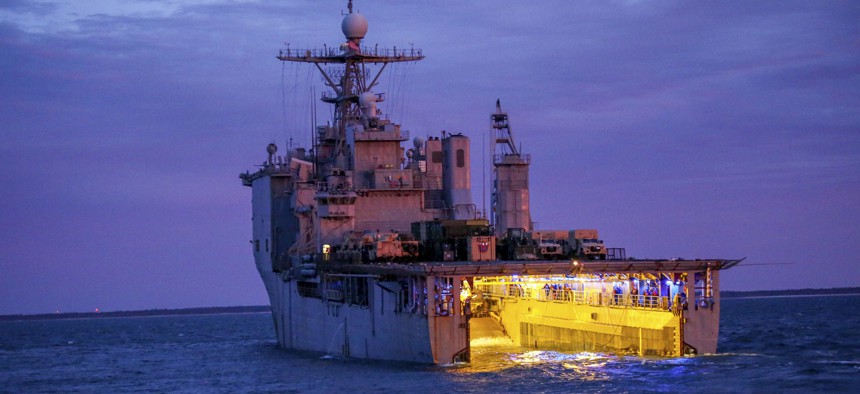
Congress quashed Navy plans to retire the 28-year-old amphibious dock landing ship Carter Hall, shown here practicing an amphibious assault off Camp Lejeune, N.C. U.S. Marine Corps / 1st Lt. Mark Andries
Marines Issue Warning on Amphib Fleet
The assistant commandant says 31 large amphibious warfare ships are needed to avoid risk.
The U.S. takes on more risk when it doesn’t keep a fleet of 31 large amphibious warships, the Marine Corps’ No. 2 officer said Tuesday. The Navy had plans to cut the fleet to as few as 24 until Congress intervened last fall.
“Every time that number dips below 31, that is increased risk passed to a combatant commander, passed to a junior commander, passed to a lance corporal, passed to a seaman. So 31 is the answer and we can't accept less. And when it does, we just have to highlight that there's increased risk now for us, for those American citizens waiting to be evacuated for humanitarian assistance disaster relief operations,” Gen. Eric Smith, the Marines’ assistant commandant, said in a keynote speech at WEST 2023 in San Diego.
Smith noted that Chief of Naval Operations Adm. Mike Gilday and Marine Commandant Gen. David Berger see eye to eye on the need for 10 big-deck amphibious assault ships and 21 amphibious transport dock ships. Both leaders testified as much last May during a Senate Armed Services Committee hearing.
But the Navy, which has called new ballistic missile submarines its top acquisition priority, planned to let the large-amphib fleet slip to as few as 24 ships next year before returning it to 31 in 2030.
Congress said no to that plan, writing the requirement for 31 larger amphibs into the 2023 National Defense Authorization Act. In the 2023 omnibus bill, lawmakers restored funding for four dock landing ships, or LSDs, that the Navy had sought to retire.
Smith said the LSDs “are getting old and need to be decommissioned. But they have to be replaced. The original plan, as you know, was to replace them with an LPD as the LSDs aged out.”
“We're not in disagreement about what we need. It's a funding question. And what we don't do is own the Navy [Program Objective Memorandum]. The Navy has lots of issues to pay for,” he said. “We're always going to have a discussion about [the] use of resources.”
Smith said the Marines don’t disagree with the Navy’s emphasis on the Columbia-class submarines, which will replace the decades-old Ohios.
“If you live underneath the protection of a nuclear umbrella, which we all do, you want to fund Columbia, and take the pressure off everything else in the shipbuilding account,” he said.
A minimum of 31 amphibs is needed to ensure sufficient training for Marines and sailors, Smith said.
“A young lance corporal moving their [amphibious combat vehicle] into a wet well, and [a] pitching and rolling deck and two or three footers. They shouldn't be doing that at night on the way to a war, they should be doing it today, over and over and over again until it's just rote,” he said.
Can the Marines expect more than the minimum for amphibious ships? The answer may lie in the classified Amphibious Force Requirements Study that was sent to the Congressional defense committees on Dec. 28. The study, which the Navy has said will not be publicly released, is expected to help shape “an ongoing battle force ship assessment that will be published later this year,” Lt. Gabrielle Dimaapi, a spokeswoman for the Navy secretary, said in a January email.




